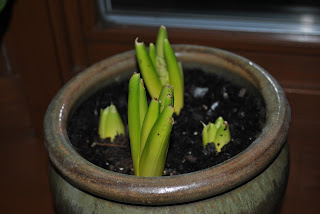Scarify: To nick or lightly scour a seed coat to facilitate the absorption of moisture.
Stratify: To expose seeds to cold temperatures and/or moisture to encourage germination.
Note: These are my definitions, not from a particular dictionary or necessarily reputable source.Essentially scarification and stratification are ways to get seeds to sprout. Not all seeds need these forms of preparation, but some, especially those you gather yourself, often benefit from one or both of these activities. If you think about it, it makes sense: in a natural setting, seeds are scattered from a spent flower and then buried in the ground over the winter where they are bumped and jostled by soil, gravel, ice, and any other matter in the ground. Or they are eaten by birds or other animals and then passed through their digestive tracts. Any seed wanting to survive that ordeal had to evolve a seed coat strong enough to withstand stomach acids. And in cold places like here (zone 5), the winter was a normal part of plants' life cycles, to which seeds also had to adapt.
But I like to collect seeds from my plants rather than leave them at the mercy of Mother Nature. Consequently I help them along by cold stratifying them in the refrigerator for a few months, and, for those that have a hard seed coat, I scarify and moist stratify them before starting them. It's really not that hard, either. Here's what I do:

These are the things you need. Really, not that much stuff. I will be scarifying two types of seeds (in the envelopes): columbine (
Aquilegia canadensis) and nodding wild onion (
Allium cernuum). The latter are
blogalong passalong seeds from plants I got from
Mr. McGregor's Daughter. Both of these envelopes have been (literally) chilling for three months. I have one piece of sandpaper, two paper towels folded up, two ziploc bags and a marker to write on the bags. That's it! (And you will need a refrigerator but if you're reading this on a computer, I figure you would already have such a basic appliance as a fridge.)
Many seeds of native plants from temperate climates benefit from cold stratification (i.e., leaving them in the fridge for a couple months). But as I mentioned before, not all seeds need to be scarified or moist stratified. The ones that do need this treatment have hard seed coats, like these columbine seeds (enlarge for best look):

See how they reflect the light? That's their solid, thick seed coat. Here's an even better example, the alliums:

They have a very tough coat. As a result, nicking this outer covering allows moisture to get inside and help the seed cells to germinate. Now here is an example of a seed that does
not need scarification or moist stratification, purple hyssop (
Agastache foeniculum):

Please enlarge that for a better look. It's hard to really see this unless you're holding the seeds in your hand, but they're smaller and not reflecting the light with a thick, hard coat. If you scarify a seed like this you can damage it. Moist stratification can do the same thing. I found that out the hard way one year when I moist stratified seeds from my tall coreopsis (
C. tripteris), and they literally disintegrated. All coreopsis, purple coneflowers, and black-eyed susans are just a few of the native plants that do not need moist stratification. But if you have seeds with a thick, hard seed coat, here are the next steps:

Put the seeds on the sandpaper. This one is a fine-grained sheet, but I've used coarser grained too.

Lightly rub the seeds with the sandpaper. You can see I'm not grinding away at them; I just used my open palm to move the sandpaper over the seeds with light pressure for about 10 seconds. That's all there is to scarifying!

Now place the seeds on a moistened paper towel. Make sure it's just damp, not soaked.

Fold the seeds inside the moistened paper towel.

Seal the paper towel in the ziploc bag and mark what it is and when you prepped them. I put these back in the fridge where they'll stay for four weeks. After that I'll start them like any other seeds in soilless potting medium and a sunny window.
That's all there is to it! If you'd like to learn more about cold and moist stratification, here is a link to a helpful page on
Prairie Nursery's website.
If you like collecting your own seeds, this is an easy way to help them along. Remember, do try this at home!



















